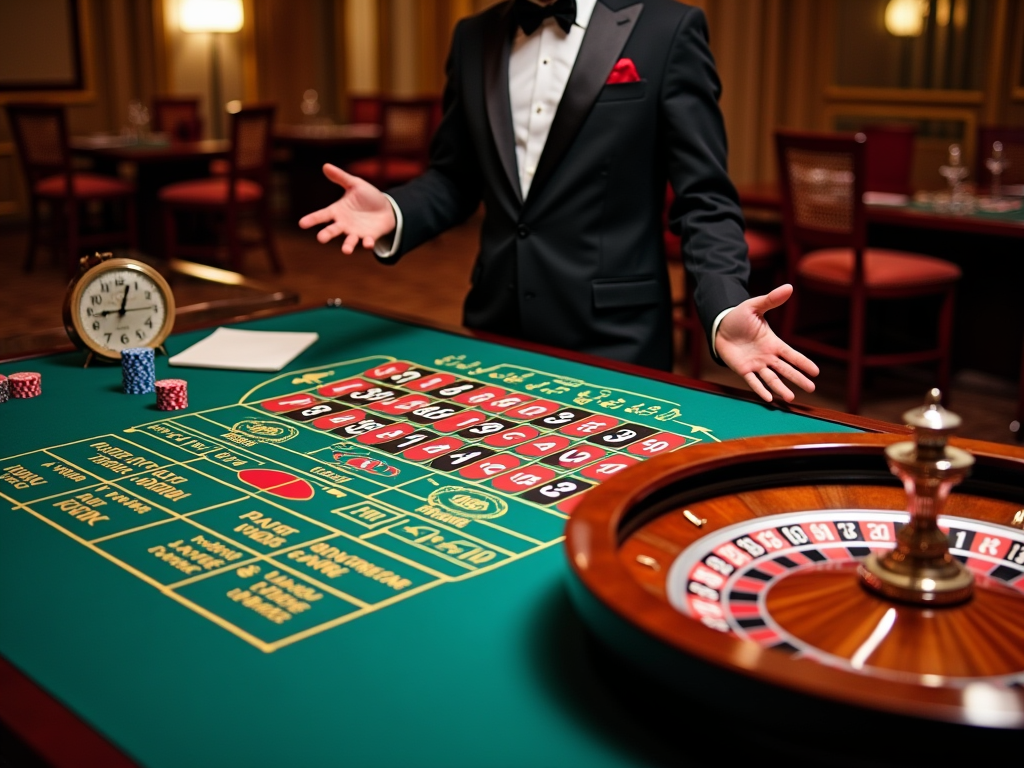Mastering Roulette: Strategies for Smart Play and Bankroll Control
Roulette stands as one of the most captivating casino games, blending strategic money management with thrilling betting action. European and American roulette variations each require specific betting approaches and careful bankroll control to create an enjoyable gaming experience.
Key Takeaways
- Set clear betting limits at 1–5% of your total bankroll and establish specific win goals and loss limits
- Choose European Roulette over American for better odds with a 2.70% house edge versus 5.26%
- Outside bets offer better winning chances with smaller payouts, while inside bets provide higher risk and rewards
- No betting system can overcome the house edge, so use them for entertainment rather than guaranteed profits
- Treat roulette as entertainment by setting time limits, taking regular breaks, and never chasing losses
Essential Roulette Strategies
I’ve learned that successful roulette play demands smart bankroll control and solid betting strategies. My experience shows that European roulette gives players better winning chances thanks to its single zero layout. The game’s true excitement stems from balancing risk with potential rewards through careful bet selection.
Promoting Responsible Gambling
Responsible gambling practices form the foundation of extended roulette enjoyment. Setting strict betting limits prevents emotional decisions, while regular breaks maintain clear judgment. This structured approach has helped me maintain control while still experiencing the thrill of each spin.
Smart Betting Choices
Small, consistent bets on outside chances build steadier results than aggressive inside betting. Still, mixing bet types adds variety without excessive risk. My tested approach focuses on steady play rather than chasing big wins, which has led to longer, more satisfying sessions.
Smart Money Management: The Key to Longer Roulette Sessions
Setting Your Betting Parameters
Before I sit down at the roulette table to start placing bets, I always establish clear financial boundaries. The smartest approach is limiting each bet to 1-5% of your total bankroll — for instance, if you’re playing with $200, keep your bets between $2 and $10. This strategic approach helps protect your funds while giving you enough flexibility to enjoy the game.
I’ve found that setting specific win goals and loss limits creates a structured gaming session. For example, you might decide to stop playing once you’ve won 50% of your initial bankroll or if you lose 30%. These predetermined limits act as guardrails, preventing emotional decisions that often lead to larger losses.
Maintaining Control During Play
Chasing losses is one of the most dangerous traps in roulette. When you’re down, it’s tempting to increase your bets to recover quickly. However, this usually leads to even bigger losses. Instead, I stick to my original betting strategy regardless of whether I’m winning or losing.
Here are my essential rules for maintaining control during your roulette session:
- Always track your wins and losses clearly
- Take regular breaks to assess your current position
- Never borrow money or exceed your predetermined bankroll
- Stop playing immediately when reaching either your win goal or loss limit
- Keep your betting amounts consistent throughout your session
The moment you reach either your win goal or loss limit, it’s crucial to step away from the table. This discipline might feel challenging, especially during a losing streak, but it’s the cornerstone of responsible gambling and long-term enjoyment of the game.
Remember to treat your roulette bankroll as entertainment money — funds you can afford to lose without impacting your daily life. This mindset helps maintain a healthy relationship with the game while maximizing your enjoyment at the tables.
Choose European Roulette for Better Odds
I strongly recommend picking European Roulette over its American counterpart to boost your winning chances. The difference between these two variations directly impacts your potential returns and overall gaming experience. Let me break down why European tables give you a significant mathematical advantage.
Understanding the House Edge Differences
The European wheel’s single zero layout results in a house edge of 2.70%, making it significantly more player-friendly than the American version’s 5.26%. This stark difference exists because European Roulette features 37 pockets (numbers 0-36), while American tables include an extra double zero (’00’) pocket, bringing their total to 38.
Here’s what stands out about European Roulette:
- Single zero pocket reduces the house advantage
- Better odds on every type of bet you place
- Identical payouts to American Roulette but with improved winning chances
- Option to find French variants with La Partage or En Prison rules
I especially recommend seeking out French Roulette tables when possible, as their special rules can cut the house edge down to 1.35%. The La Partage rule returns half your stake on even-money bets when zero hits, while En Prison gives you a second chance to win by ‘imprisoning’ your bet for another spin.
Playing on a European roulette table improves your odds of walking away with wins, thanks to its more favorable structure. The math is clear – why accept nearly double the house advantage on an American wheel when European tables offer the same exciting experience with better winning potential?
Inside vs Outside Bets: Understanding Your Options
Let’s break down the betting options in roulette to help you make smarter choices at the table. I’ve found that understanding the difference between inside and outside bets can dramatically improve your gaming strategy.
Inside Bets: High Risk, High Reward
Inside bets focus on specific numbers or small number combinations on the roulette table. Here are the main types of inside bets and their payouts:
- Straight Up: Pick a single number for a massive 35:1 payout
- Split: Bet on two adjacent numbers for 17:1 returns
- Street: Cover three numbers in a row for 11:1 odds
- Corner: Select four numbers that meet at a corner for 8:1 payout
- Six Line: Place chips on six numbers across two rows for 5:1 odds
These bets are perfect if you’re feeling lucky and want to chase bigger wins. I’ve seen players hit significant payouts with inside bets, though they do carry more risk due to their lower probability of winning.
Outside Bets: Better Odds, Smaller Payouts
Outside bets offer a different approach with better winning chances but smaller payouts. These bets cover larger groups of numbers:
- Red/Black: Choose your color for even money (1:1) payout
- Odd/Even: Bet on number type for 1:1 returns
- High/Low: Select numbers 1-18 or 19-36 for 1:1 odds
- Dozens: Pick groups of 12 numbers for 2:1 payout
- Columns: Bet on vertical number groups for 2:1 returns
I suggest starting with outside bets if you’re new to roulette. They’ll help you stay in the game longer and build confidence as you learn the table dynamics. Once you’re comfortable, mix in some inside bets to create an exciting balance between safe plays and thrill-seeking opportunities.
Remember that each bet type serves a purpose in your overall strategy. Outside bets can provide steady, smaller wins while inside bets offer the chance for those attention-grabbing payouts that make roulette such an exciting casino game.

The Truth About Betting Systems
Understanding Popular Betting Systems
Let me share the real story behind roulette betting systems that many players swear by. While these strategies can add structure to your gameplay, they’re not the magical solutions some might claim. The most well-known system is the Martingale, where you double your bet after each loss. For example, if you bet $5 and lose, your next bet would be $10, then $20, and so on until you win. It sounds logical – when you finally win, you’ll recover all previous losses plus a small profit.
The Fibonacci system follows the famous number sequence where each number is the sum of the two preceding ones (1, 1, 2, 3, 5, 8, 13…). You move up the sequence after losses and back two numbers after wins. The D’Alembert method takes a gentler approach – you increase your bet by one unit after a loss and decrease by one after a win. The Labouchère system involves creating a number sequence and crossing off numbers as you win.
The Reality Check
I need to be straight with you about these betting systems – they can’t beat the built-in house edge. While playing roulette with a strategy might feel more controlled, the odds remain unchanged with every spin. Here’s what you should know about betting system limitations:
- Table limits will eventually stop progression systems like the Martingale from working
- Even small losing streaks can require substantial bankroll increases
- The house edge stays constant regardless of your betting pattern
- No system can predict where the ball will land next
- Each spin remains completely independent of previous results
Betting systems can help manage your bankroll and make your gameplay more engaging. However, I recommend using them primarily for entertainment rather than as a guaranteed winning method. The key is to set strict limits on your betting progression and maintain discipline in your approach.

Playing for Entertainment, Not Profit
Setting Healthy Boundaries
I’ve learned that playing roulette for entertainment requires a clear mindset and strict personal limits. Before sitting at the table, I set a specific time limit for my gaming session – typically 1-2 hours maximum. This helps maintain control and prevents fatigue from affecting my decisions. I also determine my budget beforehand and stick to it religiously, treating it as my entertainment expense rather than an investment.
Managing Expectations and Emotions
Roulette’s charm lies in its unpredictability, but this also means it can’t be relied upon for consistent profits. The house edge remains constant regardless of betting patterns or strategies. I’ve found that emotional betting – like trying to chase losses or betting more after a win streak – can quickly spiral out of control. Here’s what I do to keep my roulette sessions enjoyable:
- Set win and loss limits before starting play
- Take regular breaks every 30 minutes
- Keep track of time spent playing
- Never borrow money or use credit to play
- Avoid alcohol while gambling
- Leave when I reach either my win or loss limit
The excitement of a win is part of the entertainment value, but I don’t count on it happening. I celebrate my wins as bonuses while accepting that losses are part of the cost of entertainment. When I feel frustrated, tired, or the fun starts diminishing, that’s my cue to step away from the table – regardless of whether I’m winning or losing. By maintaining this mindset, I’ve found that roulette remains an entertaining casino game rather than a source of stress or financial strain.
Know Your Wheel: The Basics
Let me walk you through the key elements of the roulette wheel so you can feel confident when placing your bets at the roulette table. The wheel itself features numbers arranged in a specific non-sequential pattern – this isn’t random but carefully planned to create a balanced distribution of high, low, odd, and even numbers around the wheel.
Understanding the Layout
The betting grid on the table maps directly to the wheel’s number sequence, creating a consistent connection between where you place your chips and the corresponding spots on the wheel. I’ve seen many players get confused by this at first, but it’s actually quite straightforward once you grasp the basics:
- Numbers alternate between red and black, with green zero spaces breaking the pattern
- The European wheel contains numbers 0-36
- The American wheel adds a double zero (00)
- High numbers (19-36) and low numbers (1-18) are distributed evenly
- Odd and even numbers are spaced throughout the wheel’s circumference
The croupier stands as your guide through each betting round, clearly announcing when you can place bets and when betting closes. They’ll spin the wheel in one direction while releasing the ball in the opposite direction, creating that signature suspenseful moment as everyone watches to see where it lands. The winning number and its color determine which bets pay out – it’s that simple.
The betting sequence runs smoothly:
- The croupier announces “place your bets“
- They spin the wheel
- They launch the ball
- They declare “no more bets” before the ball drops
- Once the winning number is determined, they’ll mark it with a special marker called a dolly
- They clear losing bets and pay out winners
- The next round begins
Sources:





